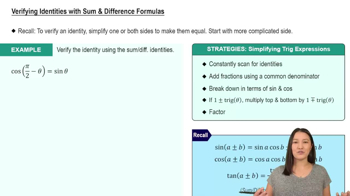Here are the essential concepts you must grasp in order to answer the question correctly.
Sum and Difference Formulas
Sum and difference formulas are trigonometric identities that express the sine, cosine, and tangent of the sum or difference of two angles. For sine, the formula is sin(a ± b) = sin(a)cos(b) ± cos(a)sin(b). These formulas are essential for breaking down angles that are not standard, such as 195°, into manageable components that can be evaluated using known values.
Recommended video:
Verifying Identities with Sum and Difference Formulas
Reference Angles
A reference angle is the acute angle formed by the terminal side of an angle and the x-axis. For angles greater than 180°, like 195°, the reference angle helps determine the sine, cosine, and tangent values by relating them to angles in the first quadrant. The reference angle for 195° is 195° - 180° = 15°, which is crucial for finding the exact value of sin(195°).
Recommended video:
Reference Angles on the Unit Circle
Unit Circle
The unit circle is a circle with a radius of one centered at the origin of a coordinate plane. It provides a geometric representation of the sine and cosine functions, where the x-coordinate corresponds to cosine and the y-coordinate corresponds to sine. Understanding the unit circle is vital for evaluating trigonometric functions at various angles, including those expressed in degrees like 195°.
Recommended video:
Introduction to the Unit Circle
 Verified step by step guidance
Verified step by step guidance


